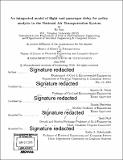| dc.contributor.advisor | Amedeo R. Odoni and Dimitri Bertsekas. | en_US |
| dc.contributor.author | Sun, He, S.M. Massachusetts Institute of Technology | en_US |
| dc.contributor.other | Massachusetts Institute of Technology. Department of Electrical Engineering and Computer Science. | en_US |
| dc.date.accessioned | 2016-09-13T19:26:10Z | |
| dc.date.available | 2016-09-13T19:26:10Z | |
| dc.date.copyright | 2016 | en_US |
| dc.date.issued | 2016 | en_US |
| dc.identifier.uri | http://hdl.handle.net/1721.1/104329 | |
| dc.description | Thesis: S.M. in Transportation, Massachusetts Institute of Technology, Department of Civil and Environmental Engineering, 2016. | en_US |
| dc.description | Thesis: S.M., Massachusetts Institute of Technology, Department of Electrical Engineering and Computer Science, 2016. | en_US |
| dc.description | Cataloged from PDF version of thesis. | en_US |
| dc.description | Includes bibliographical references (page 99). | en_US |
| dc.description.abstract | Demand for air travel has increased over the years and so have airport delays and congestion. Delays have a huge impact on airline costs and influence the satisfaction of passengers, thus becoming an important topic of research in the field of air transportation. In recent literature, a Passenger Delay Calculator (PDC) was proposed to estimate passenger delays. The PDC computes passenger delays for a specified day based on actual flight schedules, fight cancellation information, and ticket booking information. However, since actual fight schedules are a necessary input, the PDC cannot be applied directly to hypothetical scenarios, in which different cancellation strategies are implemented and their impact on passenger delays are evaluated. A different model. Airport Network Delays (AND), has also been developed recently. The AND model estimates fight delays and relies on an input in which demand consists of the national planned fight schedule for any given day. In this thesis, we have attempted to incorporate these two models, the AND and the PDC, within a single framework, so that the resulting new integrated model can compute passenger delays without requiring an actual flight-schedule input. The integrated model would certainly increase the usefulness and applicability of the PDC since it could be used with hypothetical scenarios, different flight cancellation strategies, etc. We first describe the framework of the integrated model for studying flight delays and passenger delays at a daily scale. The integrated model includes four components: a Tail Recovery Model, Flight Cancellation Algorithms, a Refined Airport Network Delay (RAND) model, and the PDC. The Tail Recovery Model recovers missing tail numbers for many flights recorded in the Aviation System Performance Metrics (ASPM) database. The Flight Cancellation Algorithms implement alternative strategies for flight cancellations in the presence of large delays, such as cancelling flights with long flight delays or flights with a large ratio of flight delay divided by the seating capacity of the aircraft. The RAND model is an extension of the AND, in which two implicit assumptions of the AND model have been modified. The RAND model produces better estimates of flight delays in the sense of replicating actual flight delays obtained from the ASPM database. The overall integrated model is able to compute passenger delays and relies only on planned flight schedules rather than actual flight schedules. Moreover, the integrated model facilitates the study of factors that influence flight delays, such as weather conditions and demand fluctuations, and evaluates the impact of different cancellation strategies on passenger delays. Using actual data from different days, we conclude that passenger delays can be reduced on the busiest traffic days through improved flight cancellation strategies. In the second part of the thesis, we extend the RAND model to compute flight delays on a monthly scale using different capacity profiles as input. These capacity profiles can be directly obtained from Federal Aviation Administration (FAA) reports or constructed by using classical machine learning algorithms on airport-level data. We validate our estimation of flight delays by using data of January, 2008, showing that both the capacity profiles and the RAND perform well in terms of replicating the actual monthly flight delays. These results imply that an effort can be made to develop an integrated model incorporating the RAND, the PDC etc. at a monthly scale or even at any generic time scale. | en_US |
| dc.description.statementofresponsibility | by He Sun. | en_US |
| dc.format.extent | 99 pages | en_US |
| dc.language.iso | eng | en_US |
| dc.publisher | Massachusetts Institute of Technology | en_US |
| dc.rights | M.I.T. theses are protected by copyright. They may be viewed from this source for any purpose, but reproduction or distribution in any format is prohibited without written permission. See provided URL for inquiries about permission. | en_US |
| dc.rights.uri | http://dspace.mit.edu/handle/1721.1/7582 | en_US |
| dc.subject | Civil and Environmental Engineering. | en_US |
| dc.subject | Electrical Engineering and Computer Science. | en_US |
| dc.title | An integrated model of flight and passenger delay for policy analysis in the National Air Transportation System | en_US |
| dc.type | Thesis | en_US |
| dc.description.degree | S.M. in Transportation | en_US |
| dc.description.degree | S.M. | en_US |
| dc.contributor.department | Massachusetts Institute of Technology. Department of Civil and Environmental Engineering | |
| dc.contributor.department | Massachusetts Institute of Technology. Department of Electrical Engineering and Computer Science | |
| dc.identifier.oclc | 958280399 | en_US |
